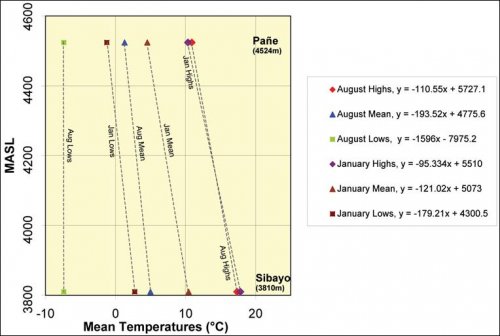Models based on local meterological data
Monthly mean temperature data collected from 1952 - 1970 at local meteorological stations show highs, daily means, and lows, and the considerable differences from the lapse rate function that probably result from the dramatic diurnal temperature variations and the relatively thin atmosphere in this region. The seasonal effects on lapse rate can be considered by looking more closely at data from the nearest reliable weather stations, at Sibayo and Pañe.
Figure4-4. Comparison of Temperature highs, means, and lows for August and January from two meteorological stations with records kept between 1952-1970(ONERN 1973).
|
August (winter, dry) |
January (summer, rainy) |
||||||
|
Altitude |
Lows |
Mean |
Highs |
Lows |
Mean |
Highs |
|
|
Sibayo |
3810 |
-7.4 |
5.0 |
17.3 |
2.7 |
10.4 |
17.8 |
|
Pane |
4524 |
-7.8 |
1.3 |
10.9 |
-1.2 |
4.5 |
10.3 |
|
Maymeja |
5000 |
-10.2 |
1.0 |
6.6 |
-3.6 |
0.6 |
5.6 |
|
Temp. Change / 100m |
-0.5 |
-0.1 |
-0.9 |
-0.5 |
-0.8 |
-1.0 |
|
Figure 4-5. Mean monthly temperatures (°C) from data in ONERN (1973). Inferred temperatures at the Maymeja area of the Chivay obsidian source shown in italics.
Figure4-6. Precipitation by Altitude (left), precipitation in the study area (lines represent highs, averages, and lows) is highly seasonal as shown in 14 yr precipitation record from Sibayo on right. Data from ONERN (1973).
The local relationship between altitude, temperature, and precipitation on the dry western slopes of Arequipa are evident in these data derived from tables provided by ONERN (1973, Appendix II). Diurnal temperature variation, highest during the dry winter months of July, August, and September results in a steep lapse rate such that low temperatures in Sibayo, near the lowest part of the study area, are only 3° C warmer than those mean winter lows at the Chivay source. Curiously, the high temperature values cross over between summer and winter months (
Figure4-4) resulting in somewhat more of a temperature difference between Sibayo and Pañe during the rainy summer months than the winter months, probably reflecting the higher precipitation at altitude. As most precipitation, including snowfall, comes during the summer months of January and February, greater cloud cover and reduced solar insolation at altitude are expected during the summer months.
At the Chivay obsidian source the inferred temperature values are in keeping with observations made during the course of research at the source in August and September 2003, as will be discussed below. This is not to suggest that the modern climate regime existed during prehispanic times, but these relative contrasts in temperature and precipitation values throughout the Upper Colca study area probably have existed throughout the Holocene although actual precipitation and temperatures varied from those of the modern conditions. Paleoclimatic reconstructions from the Terminal Pleistocene and through the Holocene using data from cores collected in large lakes and glaciers were discussed in Chapter 3.
It is important to stress that adiabatic lapse rate temperature estimates do not account for other important factors affecting local climate such as local insolation, vegetative cover, and wind, as well as temperature contrasts due to solar heating where the atmosphere is thin, and temperature inversions in mountain valleys (uncommon at tropical latitudes). Further, orographic effects such as mountain and valley winds have specific and localized effects in the Upper Colca survey blocks. Seasonality in the upper Colca region includes rain and snowfall in the highest reaches during the wet summer months as well as a high incidence of lightning strikes (a major cause of death in the Peruvian highlands today). Modern herders in the Colca area adapt to these conditions by distributing their impacts and exploiting the high altitude resources primarily during the dry season.



